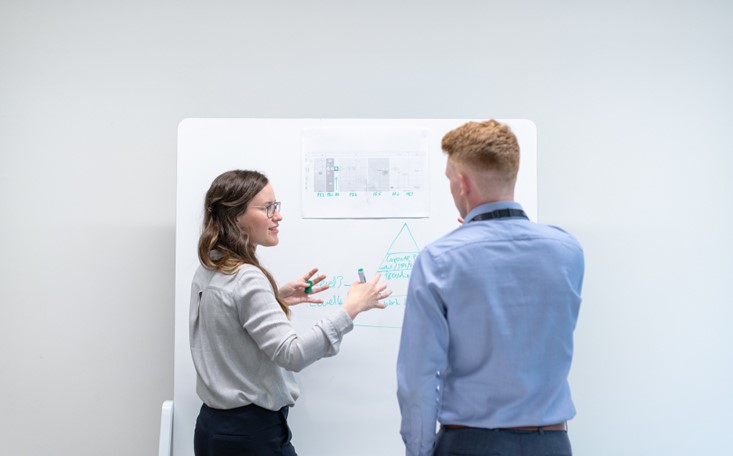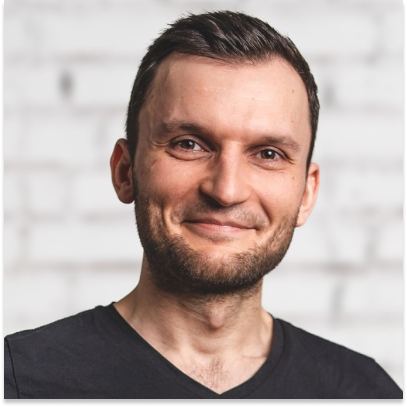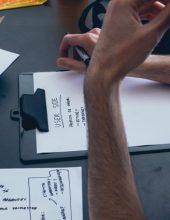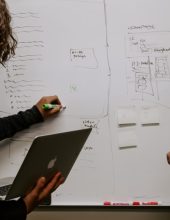Many people, upon seeing the title of this article, may wonder how a UX Researcher can conduct workshops with clients and project teams since they are responsible only for conducting research, analyzing and presenting research results at one of the meetings that will take place during the project.
I want to surprise you here, but in my case, workshops with clients, especially at the beginning or even before the project itself, are crucial to understanding and looking at the challenge or problem from the client’s perspective. The reason is straightforward – the more information, data, and context I gather about a given project, the better the research scope will be prepared to avoid unnecessary delays or erroneous assumptions.
As a result, the project team will receive a report or recommendations that will enable them to start designing according to user needs, taking into account the direction the client wants the project to follow.
I invite you to familiarize yourself with my perspective.
Why conduct these workshops? How is it different from a meeting?
From my experience, one workshop, whether with a client or a project team, can reduce the number of unnecessary meetings by half. Of course, meetings like project statuses are needed to know what objectives have been achieved and what potential problems are beginning to loom on the horizon. If these problems start to hinder the entire project, it is a sign to plan a workshop with the client or the team.
Moreover, after meetings, there is often a so-called “email ping-pong” where information circulates, and there is never certainty that all participants are on the same page regarding current project knowledge. The biggest threat in such a situation is endless discussions and blurred responsibility, which ultimately leads to indecision and the need to organize another meeting. Often, there is also the issue of lack of meeting documentation or the creation of a memo where not everything is clear to other participants.
In contrast to meetings, workshops inherently have a clear structure and focus participants’ attention in one place, e.g., on a whiteboard, where documentation and solutions are generated. During a workshop, we deal with a process that allows participants to create a transparent result in the form of a roadmap, action plan, or recommendations. All artefacts generated during the workshop are tangible, and everyone can use them at any time.
Participants work together but individually on the final workshop outcome, minimizing unnecessary discussions. In summary, if we have a choice between organizing a meeting and a workshop, always choose the workshop.
Goal of workshops
When designing workshops, it is essential to always have a defined goal that we want to achieve during the workshops. Sometimes the goal is too general, and the workshop does not bring the expected results or solutions. It is also necessary to make sure that the goal is understandable to other participants and that they agree with it.
Participant Engagement
Workshops are, by definition, teamwork aimed at achieving a specific result or solution. A regular meeting can be based on dry information sharing, and usually, one person shares the information while the others may agree or disagree. In such cases, discussions often arise between two participants, while the rest passively listen, which is not productive. There is little room for joint work during meetings; it is more of a confrontation of arguments that do not always stem from facts.
From the perspective of time, I can say that workshop participant is usually highly engaged in achieving the result if they have a real influence on the shape of what happens during the workshop. Of course, sporadic situations may occur where a group does not want to be active, usually not seeing the value in what they have to do (due to various reasons).
In such cases, a lot depends on the facilitator to encourage participants using different workshop support methods (e.g., asking direct questions like “What do you think? What positive aspects or threats do you see?” etc., sometimes a short break is enough for participants to quickly handle their daily tasks and have no issues “in the back of their minds”).
Knowledge and Experience Exchange
Workshops are meant to facilitate knowledge exchange and share all information with all participants regarding what we want to achieve during the workshop. We do not present our positions or statuses as in meetings, but actively “bounce” various ideas, impressions, points of view, and doubts off each other. When I write “everyone,” I mean everyone present at the workshop, while it often happens that only 2-3 people speak during a regular meeting, and the rest of the team remains silent or nods in agreement, even though they often do not entirely agree with the conclusions resulting from these meetings.
Interactive Method
A good workshop is one that engages fully, but what does that mean? The basis of this is engaging participants cognitively and, to some extent, physically. In the case of stationary workshops, many methods include stages where participants must generate ideas on sticky notes and then approach the board and stick them in the appropriate place. This approach builds a sense of “work, elaboration” in participants and motivates them incredibly to continue.
The same applies to conducting online workshops on so-called whiteboards (popular whiteboard tools – Miro, Mural). Although it may seem that “moving” the mouse does not motivate as much, it turns out that it does not negatively affect achieving workshop goals. The workshops I conducted during remote work did not differ in quality from those held in person, and sometimes they provided a greater sense of common purpose.
Persistent Artifact
A significant issue I often observe as a meeting participant is the frequent lack of a person to take notes of all the gathered information. Most often, I encounter situations where everyone is taking “some” notes, and then someone is seeking to “combine” that “something” into one document shared with others after the meeting. Such a document often looks like a copy of all the notes with a brief summary in bullet points, meaning there is no clarity and elaborated results.
In the workshop method, however, the “artefact” is the entire meeting process and the final result. In stationary workshops, it is a good habit for the facilitator to document the steps by taking photos or making short notes at key workshop stages. In the case of remote workshops, this is even easier, as the entire whiteboard we worked on together becomes one large artefact that we can return to whenever needed.
How to prepare for workshops?
A good start when preparing for workshops is to know and understand the industry our client works in. This way, we will always have a chance to show that we are knowledgeable about the subject and have at least basic knowledge in this area, and the client will feel understood and confident that we can help them achieve their goal.
In research methods, there is something called desk research, a method through which we analyze existing data on a specific topic (reports, analyses, opinions), usually obtained from the Internet. If we are preparing for a workshop with a client, it is worth doing a simplified version of desk research, which time allows us to get a broader perspective by reading reports, and searching for information about current problems or positive news coming from the industry.
It is also a good practice to communicate who will be attending our workshops. It often happens that junior-level people attend the first workshops, which is a risky approach, as even if these people have considerable experience in the client’s industry, it can be perceived as unprofessional. Therefore, it is recommended that at least mid-level experienced people attend the first workshop to give the client a sense of greater commitment from our side.
The last and most crucial thing is to create an agenda and send it to the client. The agenda should, of course, include basic information such as:
- when the workshop will take place,
- its format – remote or in-person,
- the workshop duration,
- who will be participating from our side and the client’s side,
- and the most important thing – the goal of our workshop.
We should describe in detail what will happen during the workshop, which method will be used, and what the final result will be. There are situations where the workshop results do not meet the client’s expectations, e.g., if we declare that the workshop’s goal is to develop a clickable prototype of a web application, and the actual result achieved at the meeting is just a plan to create that prototype.
Such a situation can discourage the client from participating in further workshops, give a sense of wasting time, and consequently hinder cooperation. In summary – we should consciously manage the client’s expectations and make sure that what we want to achieve is understood and accepted by them.
Who should participate in the workshops?
An interesting and quite challenging aspect of planning workshops is the question of individual specialists’ participation. Imagine a situation – a client comes to us wanting to modify or improve their product. We plan workshops to which we invite only developers/programmers from our side (the client is convinced it’s a technical issue), and it turns out that the workshops didn’t bring any solutions.
Why did this happen? It turns out that we didn’t consider the end-user, who has a problem in a completely different matter. In this situation, we should invite a client specialist who deals with Customer Support and can provide us with the necessary knowledge, which will indicate the direction we should take to solve this problem.
From this perspective, specialists with diverse perspectives related to the product or service should appear at the workshops, at least at the first workshop with the client. This is a very demanding approach, but in the long run, it saves a lot of time and directs the project in the right direction.
How long should the workshops last?
The duration of the workshops is a topic that depends on many factors, and it is challenging to say unequivocally how long they should last. We must consider many factors such as:
- client availability,
- the method we will use,
- and the challenges we will face during the workshops.
These are not all the factors that we need to consider, but from my experience, they are some of the most important.
As for the numbers, stationary workshops should not last longer than 6 hours, while remote workshops no longer than 4 hours. Of course, in each of these workshops, we should include regular breaks and a time buffer in case something takes longer than planned. The given number of hours results mainly from the participants’ ability to focus and the energy needed to work. Beyond these amounts, people participating in the workshops lose attention and are unable to work effectively, even despite high motivation.
What workshop methods do I use?
The choice of methods depends on the possibilities we have, the time, and personal preferences. This is a very extensive and rich topic. I would like to briefly present my two favorite methods (among many others that I use when working with clients and teams) for conducting workshops. For more information on these methods, please refer to the “Sources” section at the end of the article.
LDJ – Lightning Decision Jam
This is a fast-paced workshop method that allows you to identify the challenges you face, seek solutions to the problems related to these challenges, and create an action plan to implement these solutions.
Design Studio
This method allows participants to actively engage in the live prototyping process, even if they lack expertise in the field. During the session, each participant is tasked with creating a simple prototype with the solution ideas they want to implement. The session is divided into various stages and is tailored to the participant’s abilities.
How to check if the workshops were successful?
A good habit to develop when working in a workshop format is to collect feedback after the workshops. This will allow us to better tailor future workshops to the needs and requirements of the client and give us information on what we are doing well and what we could improve.
The form can be arbitrary; personally, I use a short survey that can be easily created in, for example, Microsoft Forms or Google Forms and shared as a link or QR code after the workshop. The survey should contain a maximum of 5 questions, and there should not be too many open-ended questions requiring a written response, a maximum of 1-2 questions.
Below are examples of questions I often use in my surveys:
- How would you rate your level of satisfaction with today’s workshop? (scale of 1 to 10)
- To what extent have we met your expectations? (open-ended question)
- Would you recommend our workshop to a colleague at work? (scale of 1 to 10)
Conclusion
I hope the knowledge and experience I have been able to share with you will help you plan and conduct a successful workshop, and with each subsequent workshop, your skills will grow and you will include this type of activity as a permanent element of your cooperation with clients and teams. If you have any questions or thoughts after reading this article, I strongly encourage you to get in touch 😊
Sources
- Workshop methods
- Whiteboards helpful for remote workshops
- Tools to support workshop planning
















Leave a comment